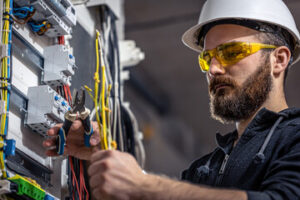A well-done sealcoat restores the rich black color of asphalt pavement and prevents it from fading to a dull gray. It also forms a protective barrier against water, gasoline, motor oil and other damaging oxidizing substances.

The first step in the process is cleaning the asphalt to prepare it for the seal coat. This is an important step and must be done correctly for the sealcoating to last. Visit https://www.rochesternysealcoating.com/ to learn more.
In addition to protecting asphalt paving, sealcoating serves as a way to boost its appearance. A fresh coat of sealant gives asphalt a rich, dark finish that enhances curb appeal and adds value to the property. It also makes it easier to spot oil or chemical spills, which can quickly damage the surface if left unattended.
Asphalt paved surfaces are exposed to many environmental elements, including UV rays and water seepage that cause deterioration over time. Sealcoating acts as a protective layer that limits the impact of these harmful environmental factors, extending the lifespan of the asphalt and significantly reducing repair costs.
Another significant benefit of sealcoating is that it acts as a way to mask minor imperfections, such as cracks and potholes, that can detract from the aesthetics of your property. A professional sealcoating contractor will ensure that the application is evenly spread across the pavement to cover any blemishes and restore the overall appearance of the parking lot or driveway.
Sealcoating is one of the most cost-effective ways to improve the look and feel of your property. Whether it is a commercial parking lot or a residential driveway, a well-maintained sealcoated surface looks new and inviting to visitors and customers. A well-maintained driveway or parking lot is an important first impression for any business or homeowner’s association, and it demonstrates that the property has been cared for and is being well maintained.
Before a sealcoating project can begin, the paving surface must be thoroughly cleaned to remove any dirt or debris that could interfere with the adhesion of the sealant. Typically, this involves power washing or using industrial sweepers. Once the surface is clean, the sealant can be applied with a squeegee or sprayer. It is important to note that it is essential to keep traffic off of the paved surface until it has had an opportunity to dry completely.
A final benefit of asphalt sealcoating is that it is a great way to restore the appearance of faded traffic markings. This can help to improve safety and navigation on the property, particularly if the parking lot is large and busy.
Durability
Sealcoating helps to prolong the lifespan of asphalt pavements, though its durability depends on many environmental factors. Proper maintenance is key to maximizing the performance of both concrete and asphalt surfaces. Seal coating is just one part of a comprehensive maintenance strategy, along with crack filling and pothole repair.
When applied correctly, sealcoating creates a layer that protects against damage caused by harsh weather conditions, UV rays, and vehicle fluids. Seal coating also makes the pavement darker, which draws heat from the sun and can help a lot of parking lots stay cooler during hot months.
Commercial parking lots experience heavy traffic, which can cause the sealcoat to wear off more quickly. This type of pavement needs regular inspections and touch-ups to ensure it stays in good condition.
A high-quality sealcoating is made of refined coal tar and contains closed ring-aromatic compounds that are not affected by harmful chemicals, including petroleum, gasoline, and oil. When properly maintained, this material protects the surface of asphalt pavement from harsh elements and helps to keep it looking like new for as long as possible.
While some business owners may consider that the cost of seal coating is not worth it, the benefits it provides can greatly outweigh the initial investment. It helps to prevent serious water damage, limits the impact of chemicals such as oils, fuels, and deicers, and gives the area a sleek finish that is sure to attract customers.
The process of applying a sealcoat is quick and easy. It is typically done with a squeegee or spray, although we can use a combination of both methods depending on the parking lot’s conditions. Once the sealcoat is applied, it should be left to dry and cure for a minimum of 24 hours. During this time, the property owner should refrain from using sprinklers, washing the area with soapy water, or any other activity that could negatively affect the results.
If you are considering seal coating your commercial parking lot, contact EastCoat Pavement for a consultation. We can provide you with a quote and estimate for your specific project. We can also give you some tips about how to keep your parking lot looking great in the future, such as sweeping and pressure washing regularly.
Safety
When properly applied, sealcoating is a safe process. However, it is an intense job and proper training must be given to anyone who will be applying the asphalt maintenance product. It is also important to have the right personal protective equipment for the job, including long sleeved shirts and pants, gloves, safety goggles, earplugs or headphones (if working near loud equipment) and a respirator mask (for jobs involving high levels of dust).
It is essential that all surfaces be cleaned thoroughly prior to sealcoating. This will remove any dirt or chemicals that may interfere with the adhesion of the new sealant. Professional pavement contractors will use blowers and rotary brooms to clean the surface, removing any dirt or debris that could cause tracking once the new coat of sealant has dried. They will also treat any oil spots and cracks with an appropriate primer before applying the sealant to the surface.
Once the asphalt has been cleaned and prepared, the sealer is usually applied with a squeegee or spray machine using either a thick nap roller or a sprayed application system. The sealant is often mixed with a sand base or aggregate for texture and durability.
The application of the sealant is typically completed in two coats. This provides the best protection to the asphalt and will help it last longer. Some people are tempted to apply just one coat, however, this is not recommended as it will only provide half the benefits of the sealant.
Another safety precaution to take is to have a fire extinguisher on hand. This is especially important if the material being used has a chemical that can burn skin. In addition, a portable eye flush kit should be kept nearby in case of any accidental contact with liquid crack filler or sealcoat.
The bottom line is that sealcoating can extend the life of your asphalt and save you from costly repairs in the future. Typically, it is recommended to have your asphalt sealcoated within the first year of installation and every 2-3 years afterward. With proper care and maintenance, your parking lot or driveway will last for decades and be a beautiful part of your property.
Environment
Aside from reviving pavements to their original lustrous ebony shade and enhancing the overall aesthetic of commercial property, sealcoating serves as a resilient armor against a variety of environmental elements. For one, it thwarts the infiltration of water, a major cause of pavement damage, by sealing off crevices and preventing water from seeping into the sub-base. It also guards against oil and other chemicals that can erode asphalt. The protective layer streamlines maintenance tasks like sweeping and snow removal, saving time and resources.
Regular sealcoating also enhances the visibility of traffic lines and markings. Clearly delineated parking lots and driveways are safer for both pedestrians and motorists, as they avert confusion and mishaps caused by unclear directions. Moreover, by filling in minor cracks and smoothing out uneven surfaces, sealcoating prevents the formation of larger crevices or potholes that can lead to car crashes or pedestrian falls.
Unlike traditional coal tar, acrylic-based seal coats are environmentally friendly, as they do not contain any polycyclic aromatic hydrocarbons or volatile organic compounds (VOCs). Additionally, these seal coating materials are biodegradable and made of recycled components and safe additives. This makes them the ideal choice for eco-conscious property owners seeking sustainable pavement upkeep.
Coal tar-based sealcoats on the other hand, release VOCs that can be harmful to humans and pets. Moreover, the odor and fumes they emit can be toxic and irritant. These substances are best avoided in commercial properties, especially when workers are present.
To become a successful sealcoating contractor, it is important to obtain the right licensing and permits. This includes obtaining business registration, a tax ID number, and securing insurance coverage. You should also research the local markets to determine what types of services are in demand and how much it costs to compete. Lastly, you must develop a marketing strategy to attract customers and boost profits.
To streamline your work and maximize productivity, consider using OptimoRoute, a route planning and optimization tool for pavement contractors. It helps you reduce the amount of time spent on manual tasks, such as calculating mileage costs and setting up service routes for your crews. By automating this process, OptimoRoute saves you valuable time and money, so you can focus on building your business.

